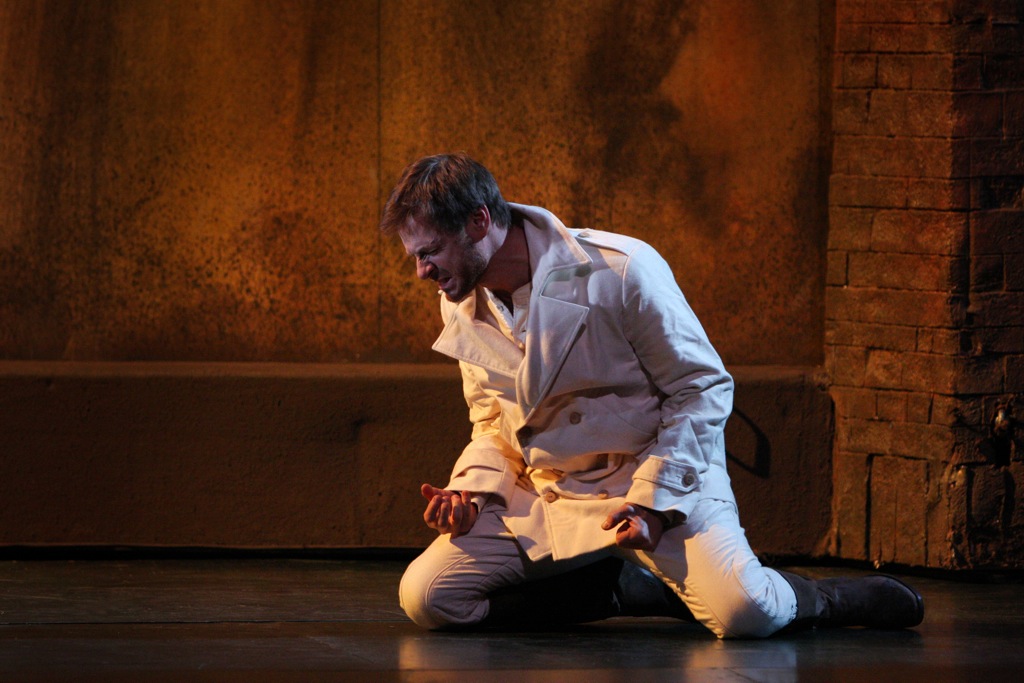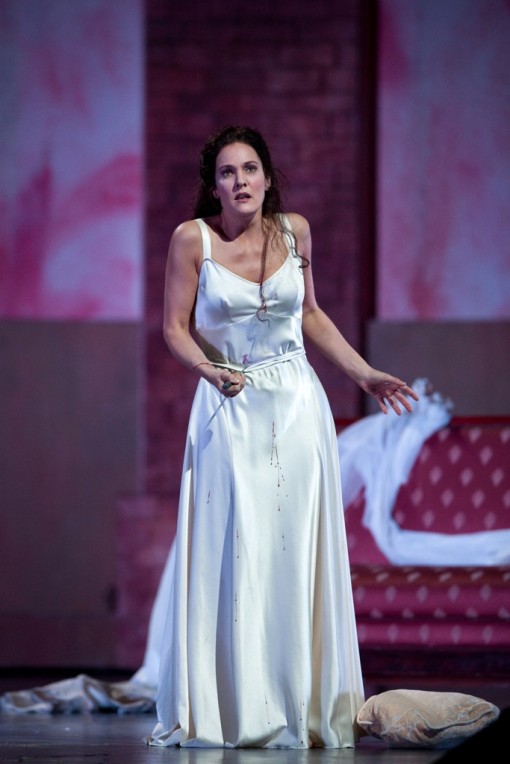The Met serves up inspired advocacy for Thomas’s flawed yet fascinating “Hamlet”

Simon Keenlyside in the title role of "Hamlet" by Ambroise Thomas. Photo: Brent Ness/Metropolitan Opera
It is easy to find fault with Ambroise Thomas’s opera Hamlet, and many have seized the opportunity to do so. The sheer idea of basing an opera on one of Shakespeare’s most complex plays aroused critical skepticism, especially in English-speaking lands, and details like a swaggering drinking song for the hero and the onstage death of Ophelia—after singing a mad scene no less—only exacerbated the hostility. As a matter of principle, the trappings and conventions of French grand opera—Hamlet had its premiere at the Paris Opéra in 1868—would seem to stifle any meaningful exploration of the issues raised by the play.
Yet it is safe to say that many who witnessed the premiere of the Metropolitan Opera’s fascinating new production of Hamlet on Tuesday evening found the experience closer to watching the Shakespeare play than they ever thought possible. Thomas may have been audacious in his choice of subject, but he also took his musical-dramatic task seriously. Although the libretto by Michel Carré and Jules Barbier expands the Hamlet-Ophelia relationship into something approximating an operatic love interest, the librettists did a thoroughly professional job of pruning the play to libretto proportions, while retaining much of its psychological dimensions.
That psychological dimension clearly meant a lot to Thomas. He devised a musical language for it that emphasizes declamation and arioso-style writing over notable tunes (of the type his Mignon abounds in). The music is by no means consistently inspired, but it is effective. Thomas’s treatment of the “To be or not to be” soliloquy, with its broken vocal line and punctuating accompaniment, is a good example. Thomas probably thought that whatever tunefulness was lacking would be compensated for by the mandatory choral numbers and ballets. These portions of the score are severely trimmed at the Met, yet given the dramatic power of the production by Patrice Caurier and Moshe Leiser and its not inappreciable length (three hours and twenty minutes, including one intermission), the omissions are not cause for complaint.
Just about every other aspect of the evening earns high praise, starting with Simon Keenlyside, whose portrayal of the Danish prince is something that straight actors could learn from. He really looks the part, scruffily dressed in an overcoat while the others are richly attired in fashions from roughly Thomas’s period (costumes by Christophe Forey). His Hamlet is intensely physical, whether curling himself up in proximity to Ophelia or stomping on the banquet table when all hell breaks loose following the play-within-the-play that Hamlet orchestrates to smoke out his stepfather Claudius’s guilt. And Hamlet’s music sounds as though it could have been written for his handsome baritone voice, which has ideal weight for the music. Keenlyside’s phrases in the melodic duet with Ophelia, Doute de la lumière emerge with succulent beauty and his fine French helps to keep the declamatory writing lively elsewhere.
This polished characterization has had a long genesis. The production, borrowed from the Grand Théâtre de Genève, dates from 1996; Keenlyside was Hamlet and the Met’s conductor Louis Langrée was also part of the initial team, which went on to perform the opera elsewhere, including London and Madrid. Keenlyside’s fine work typifies the excellent Personen-Regie that Caurier and Leiser achieve overall. Sometimes the simplest gesture is charged with tension, as when Hamlet walks slowly toward Claudius and Gertrude in Act 2 and you sense the two striving to remain composed while withering internally. Christian Fenouillat’s sets, darkly lit by Christophe Forey, consisting of faux-marblized panels in a vaguely art nouveau style, are also a plus, and they swing quickly into place to avoid breaks between scenes.
Natalie Dessay was also a member of the original cast and would have sung Ophelia at the Met but for reported illness that caused her to withdraw. Marlis Petersen, who is scheduled for Lulu later in the season, filled the breach and with captivating results. Like Dessay, Petersen has a well rounded lyric-coloratura voice that lacks any suggestion of shrillness. In her Act 2 aria she handled the octave leaps to B flat and sang with welcome energy in its cabalette. It augured well for the Mad Scene, a favorite of coloratura sopranos since the days of Christine Nilsson, who created the role of Ophelia. Petersen sang it most affectingly and with limpid tone, but the piece does go on, and it was a questionable decision to have Petersen appear alone onstage rather than in the presence of others, as with Lucia’s Mad Scene.
Another outstanding characterization comes from Jennifer Larmore, whose strongly sung Gertrude brought to mind another frazzled operatic mother, Clytemnestra. As her consort Claudius, James Morris sounded tired by comparison, but the excellent lyric tenor Toby Spence, in his Met debut, scored as Laertes and David Pittsinger sang sonorously as the Ghost of Hamlet’s father.
Louis Langrée’s conducting befits his long experience with the opera in his convincing pacing and care for instrumental detail—Hamlet includes arresting passages for saxophone. Langrée may not convince you that Thomas’s opera is consistently great musically, but he contributes decisively towards making this Hamlet the theatrical success that it is.
Hamlet runs through April 9. http://metoperafamily.org/metopera. HD broadcast March 27.

Posted Mar 18, 2010 at 5:16 pm by Napa winetenor
This fine review incented me to upgrade to a parterre box next week.
Posted Mar 19, 2010 at 3:13 am by matthew gurewitsch
What’s surprising about a mad scene for ophelia? In the play she has TWO, with songs even. And how does Langree’s conducting “befit” his experience?